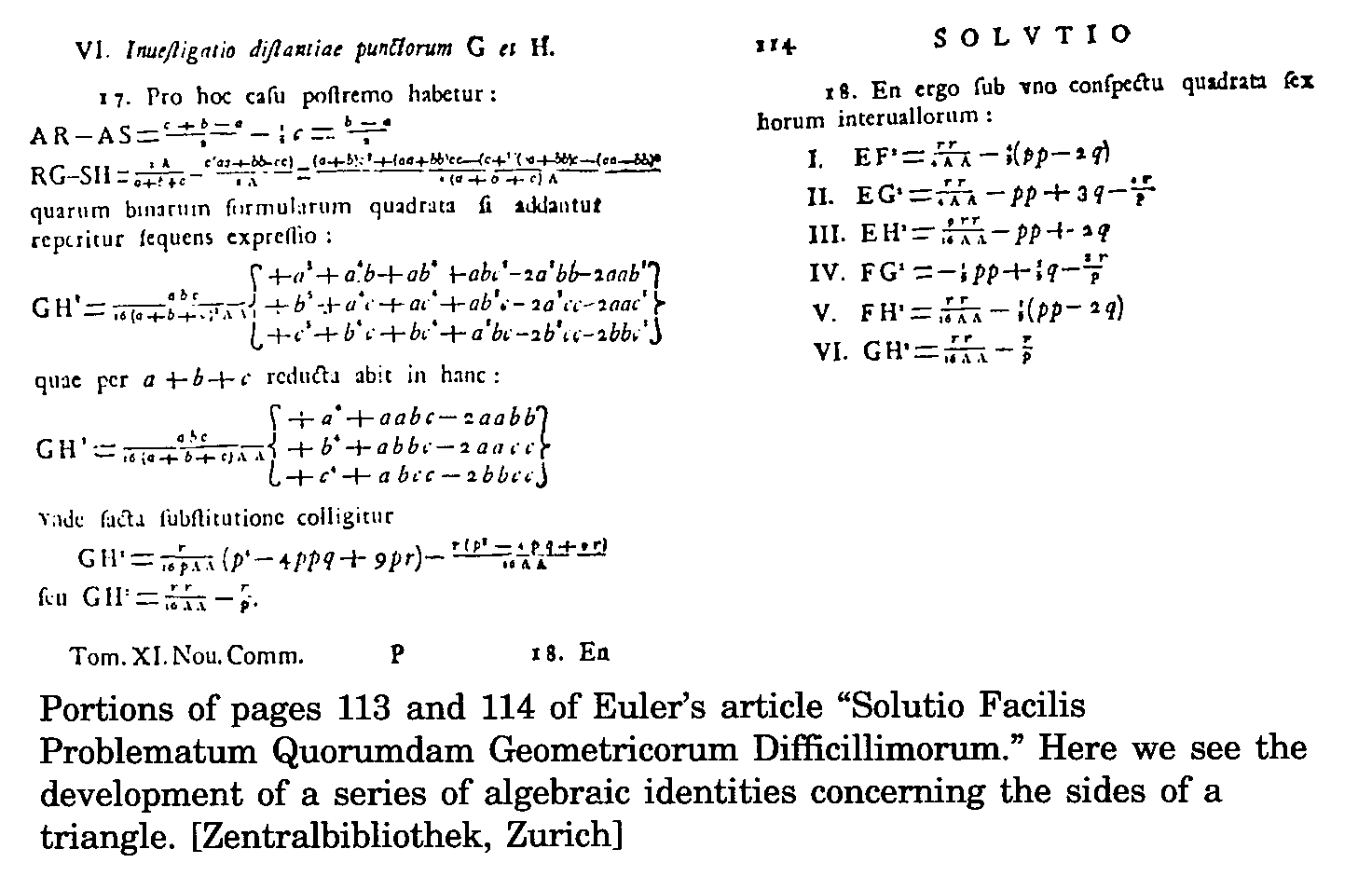
One of the most important theorems of the geometry of the triangle that was developed during the nineteenth century says that "the nine point circle of a triangle is tangent to the inscribed and to each of the three escribed circles of the triangle." The theorem was discovered and first proved by Karl Wilhelm Feuerbach, a little-known mathematician who led a short and tempestuous life. Although modern textbooks in college geometry discuss the theorem at great length, a search for additional details has been extremely interesting and fruitful (1). Furthermore, it seems that few people realize that Feuerbach, the mathematician, was a member of the famous Feuerbach family of Germany.
An early date in this story is 1821. It was in this year that Brianchon and Poncelet proved (2) that
... the circle through the feet of the altitudes of a triangle also passes through the midpoints of the sides, as well as the midpoints of the segments of the altitudes from their point of intersection to the vertices of the triangle.
Brianchon and Poncelet did not seem to have any idea that the circle in question would attract the interest of so many mathematicians in years to come. They did not give a name to the circle, and after a page or two they went on to another problem.
At almost the same time, a slender little volume of a bare 62 pages appeared in Nuremburg under the formidable title Eigenschaften einiger merkwurdigen Punkte des geradlinigen Dreiecks und mehrerer durch sie bestimmten Linien und Figuren. Eine analytisch-trigonometrische Abhandlung (Properties of some notable points of a plane triangle, and various lines and figures determined by these points, an analytic-trigonometric treatise). The title page of this book describes the author as Karl Wilhelm Feuerbach, doctor of philosophy. It may be that the book was Feuerbach's doctoral dissertation, but it is not possible to be certain whether this was the case or not. Feuerbach attended several different schools and universities, but a careful search has failed to uncover the title of his dissertation or the name of the university that awarded him the doctor's degree. At any rate, with the appearance of this book in 1822, Feuerbach completed his college studies at the University of Freiburg (Br.).
This book probably would have been long since forgotten had it not been for an inconspicuous theorem at the bottom of page 38, which states simply,
... the circle which passes through the feet of the altitudes of a triangle is tangent to all four circles, which in turn are tangent to the three sides of the triangle...
Feuerbach's proof was purely algebraic and admittedly modeled upon the proof in an article by Euler (3) of 1765. Feuerbach showed that the two circles in question were tangent by proving that the distance between the centers was equal to the sum of the radii of the circles. In outline, the proof sounds simple enough. However, one can appreciate the skill and patience that led to this discovery only by working out the details of the algebraic identities involved in the development.
Feuerbach gives only three or four references in addition to the article by Euler. It is particularly interesting to note that he refers to an article by L'Huillier, dated 1810, which appeared in Gergonne's Annales de mathematiques, and thus indicated that he was familiar with the journal that carried the aforementioned article by Brianchon and Poncelet. However, Feuerbach makes no reference to the work of Brianchon and Poncelet and was probably unaware of its existence.
One can scarcely say, as some writers claim, that Feuerbach discovered the nine-point circle of a triangle. For at no place in his book does he mention the three points that are the midpoints of the segments of the altitudes from the orthocenter to the vertices of the triangle, and he does not letter these points on his diagram. Feuerbach's description of the circle that was to become so closely associated with his name was merely the unimaginative phrase "the circle which passes through the points M, N, and P (the feet of the altitudes of the triangle)." It is nevertheless a fact that in Europe the circle is usually called the circle of Feuerbach. It seems too that Feuerbach did not realize that this one theorem was so much more significant than the others with which it was listed, and he surely did not realize that his fame as a mathematician would rest upon this single theorem.

Shortly after the publication of his book, Feuerbach, only 22 years old and without previous teaching experience, was named professor of mathematics at the Gymnasium at Erlangen. There is nothing else to indicate that the book made a deep impression upon contemporary mathematicians, or even that it had a wide circulation. In fact, 11 years later (in 1833) Steiner, writing from Berlin, said he did not know that the theorem in question had been previously proved by Feuerbach (4). In another note at the end of his book, Steiner said that the "circle is now generally known as the circle of Feuerbach." In 1842 the theorem was again submitted as an original contribution to mathematical literature and proved anew by Terquem (5). It is in this article by Terquem that the circle is first designed as the nine-point circle.
In succeeding years many articles were written about the nine-point circle. People seemed to be fascinated by the difficulties in Feuerbach's proof and seemed to find it a pleasant challenge to produce a different and far simpler proof. Two particularly detailed and exhaustive treatments appeared almost simultaneously near the end of the 19th century, one an article by the well-known Mackay (6), and the other an article by Julius Lange, professor of mathematics at the Friedrichs Wederschen Ober-Realschule in Berlin (7).
It is a little strange that so much has been written about the theorem Feuerbach discovered and that so little has been written about the man who discovered the theorem. In an article by Moritz Cantor (8) a few pages are devoted to biographical details, but by far the most poignant story of Feuerbach's short life can be read in his father's letters (9).
Karl Wilhelm was the third son in a family of 11 children
born to the famous German jurist Paul Johann Anselm. Feuerbach, and Eva
Wilhelmine Maria Troster. The first eight children in the family were boys,
and the last three were girls. Since three of the boys died in infancy,
Karl is usually spoken of as the second of five sons of the jurist. These
five sons were Joseph Anselm (1798-1851) philologist and archeologist,
and father of the famous German painter Anselm Friedrich (1829-1880); Karl
Wilhelm (1800-1834), mathematician, the subject of this article; Eduard
August (1803-1843), professor of law at the University of Erlangen; Ludwig
Andreas (1804-1872), famous philosopher; and Friedrich Heinrich (1806-1880),
orientalist.
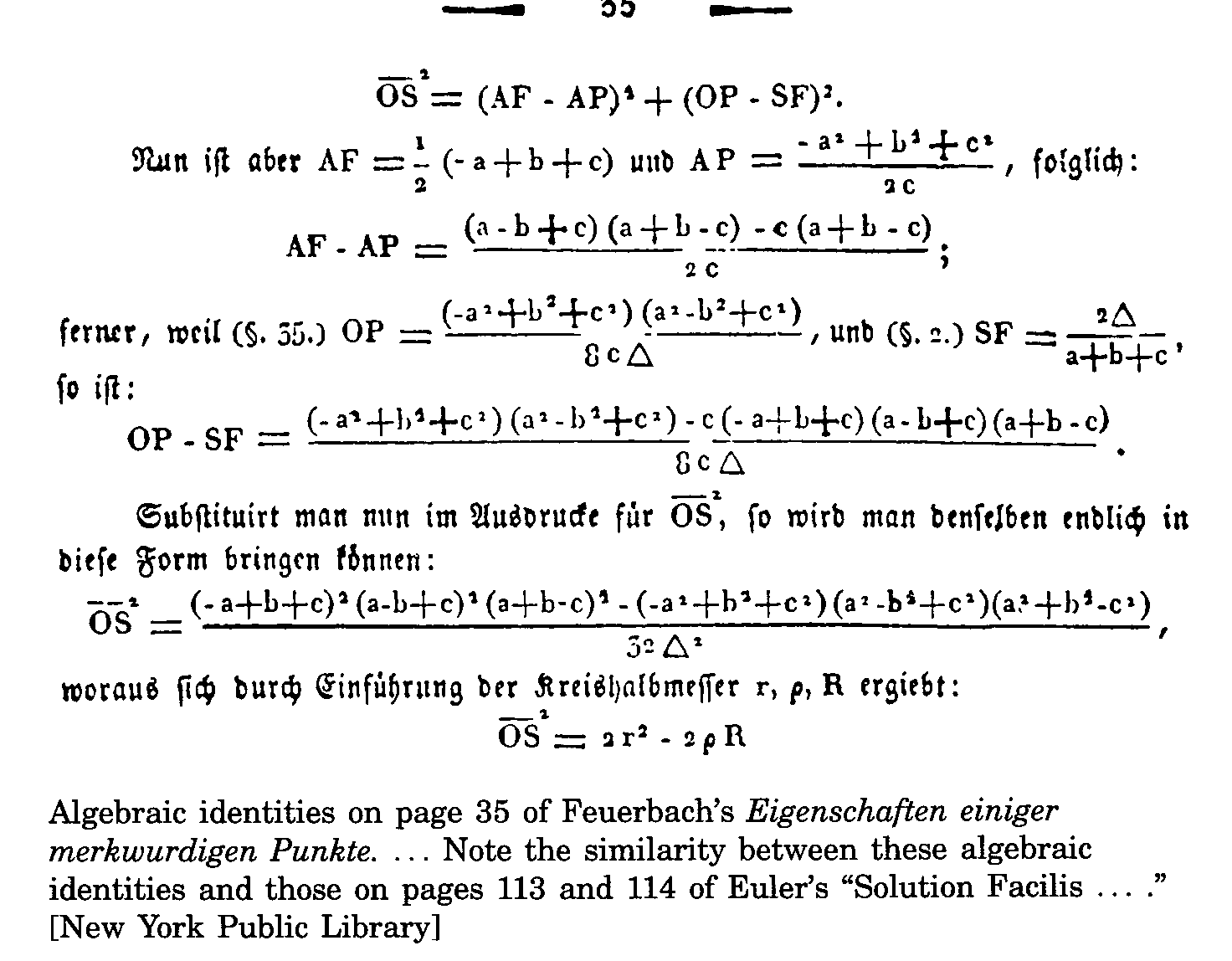
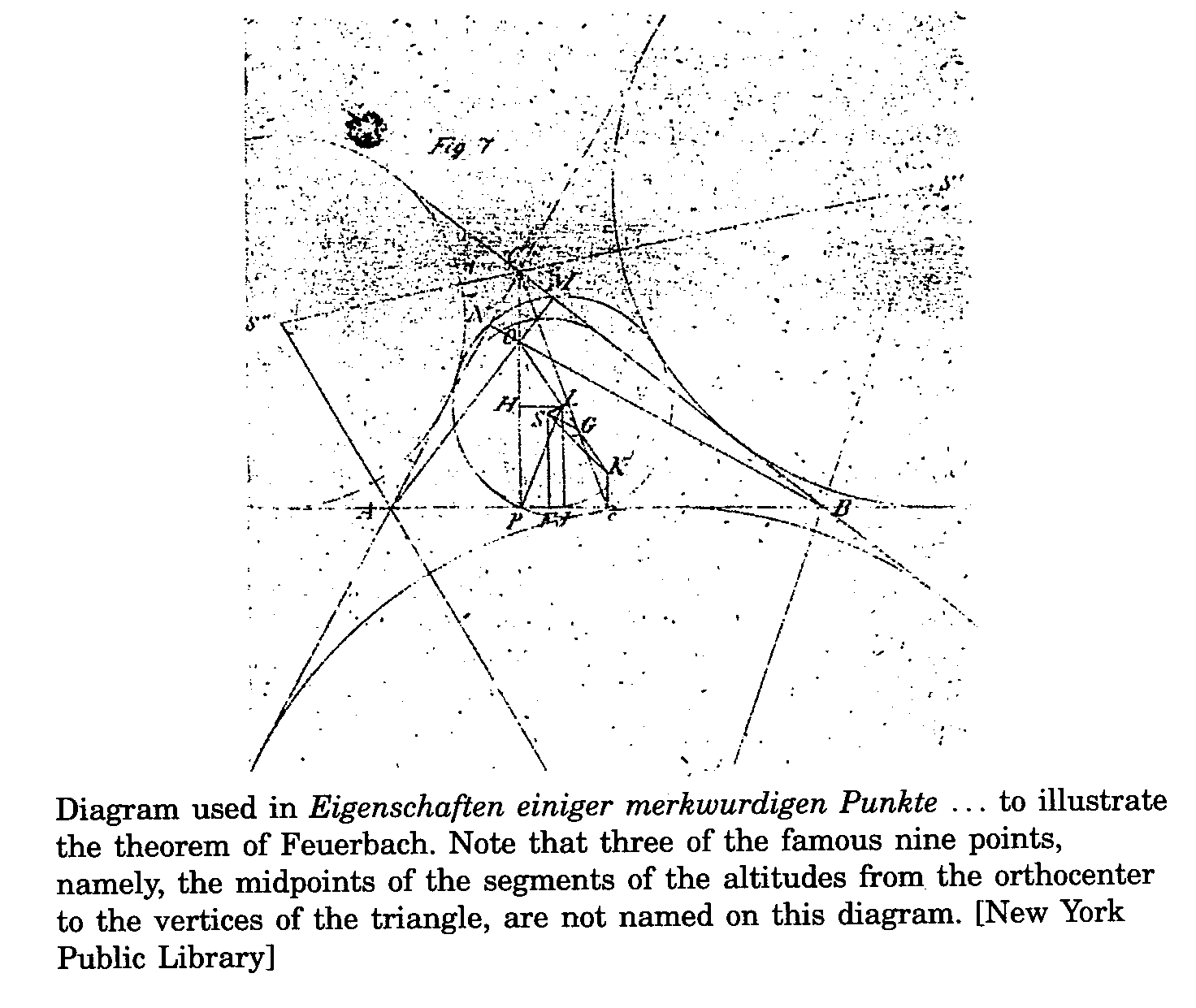
Karl was born in Jena 30 May 1800. His father, 25 years old when Karl was born, had left his home in Frankfurt at the age of 16 to study philosophy at the University of Jena. However, since there were jurists and public servants on both sides of his family, it is not surprising to learn that, as his family responsibilities increased, he was soon attracted to the more lucrative profession of the law. All manner of success came to him at a very early age. But it was a number of years before his own father, who had been angered when he left home, became reconciled to him. The young man sent many entreating letters to his father that remained unanswered. It is in one such ingratiating letter that one can read the earliest reference to Karl; his father says, in a letter from Kiel dated 16 November 1802, that "his youngest son Karl is a healthy, red cheeked, fat youngster, who runs around happily and has little thought for anything except food." In 1804 the father writes of taking his wife and three young sons with him from Kiel to Landshut in an open wagon in freezing winter weather.
As increasing fame and success came to the father, he
moved frequently from one city to another in Germany. Thus Karl, while
still a young boy, lived successively in Jena, Kiel, Landshut, and Munich.
When Karl was 14 years old his father moved again from Munich to Bamberg.
At this time, however, he left his two eldest sons, Anselm and Karl, in
school in Munich. In 1817 Anselm and Karl entered the University of Erlangen.
At Erlangen they studied under the patronage of King Maximilian Joseph,
who had ennobled their father, and who had promised to provide for the
university education of all the jurist's sons.
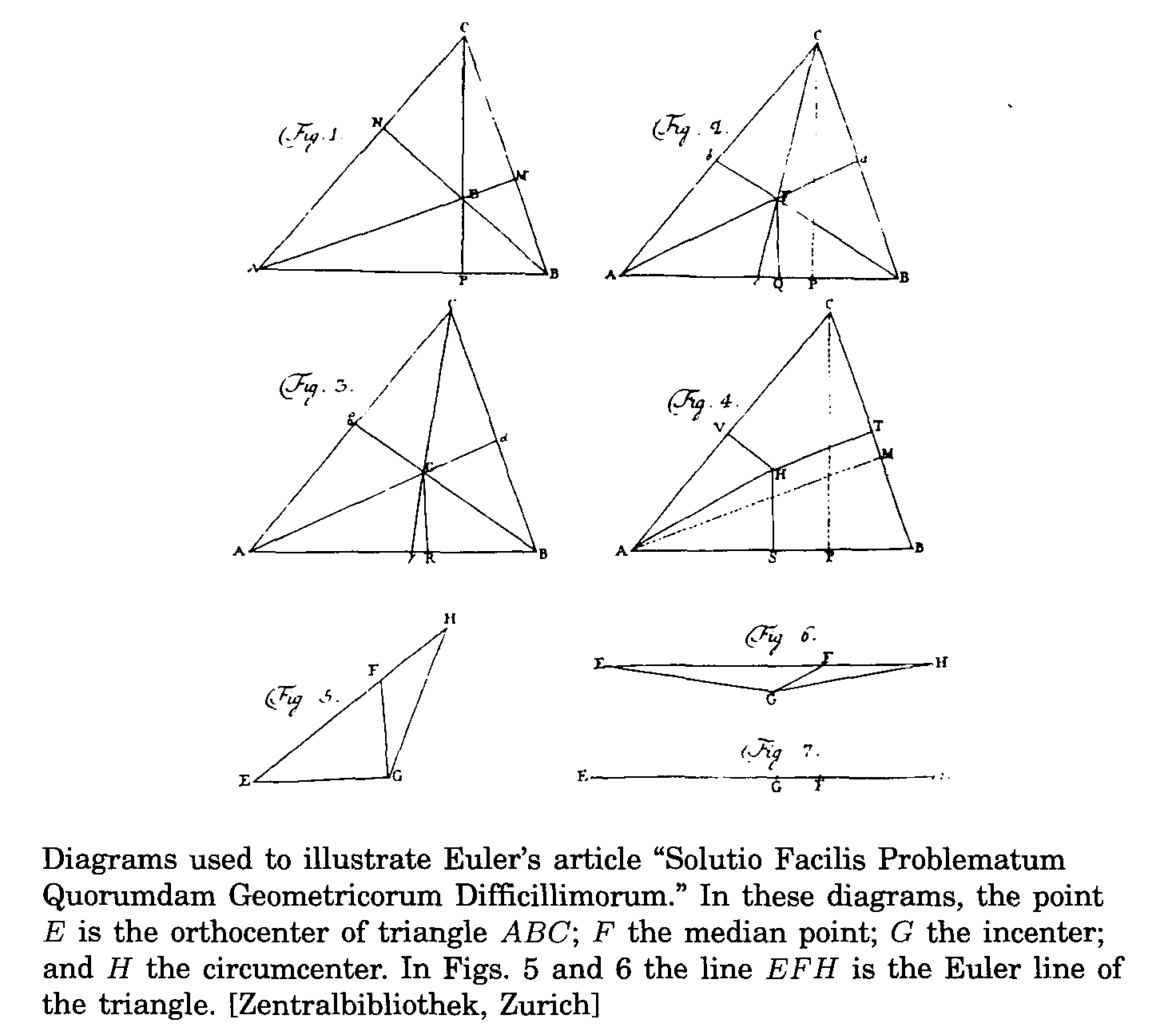
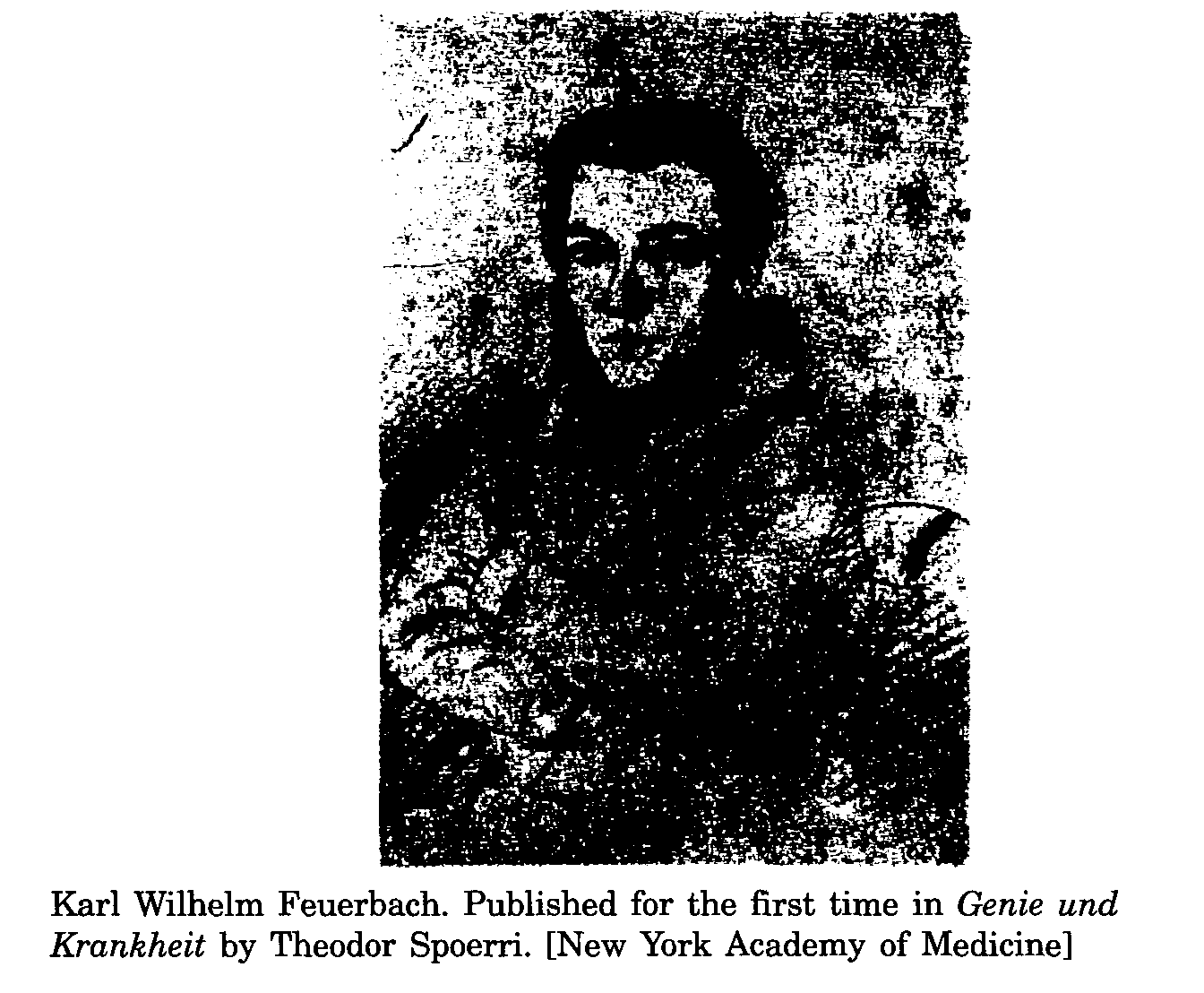
By 1819 the father had become president of the court of appeals in Ansbach. In an 1819 Christmas letter from Ansbach his father, the jurist writes at great length about Karl's gifts mathematics and physics. He says that Karl had given some thought to jurisprudence as a profession, but that it was his present ambition to become an engineer in the army.
After a short stay at Erlangen, Karl transferred to the University of Freiburg (Br.). He did so in order that he might continue his studies in mathematics with Karl Buzengeiger, who is credited with having had a great influence upon the young mathematician In fact, Feuerbach's 1822 publication Eigenschaft einiger merkwurdigen Punkte ... ) features an introduction (of 16 pages) by this same professor. No doubt Buzengeiger wish to use this means to introduce a talented young student to the academic world. However, in his introduction, he says scarcely a word about the student or any of the geometric discoveries that followed in the ensuing pages.
As the time passes, one can read the gradually growing pit and joy of the father in the son's accomplishments. He writes of the little book that Karl published in 1822 and asks a dear friend to do what she can to bring the book to the attention of influential people in Bavaria. The Feuerbachs were, after all, not native Bavarians; and moreover they were Protestants in a predominantly Catholic state. For these reasons the father feared that the son might encounter some difficulty in finding a place in the academic profession. When the son was appointed professor of mathematics at the Gymnasium at Erlangen everything seemed to be going well.
And then very suddenly, completely without warning and in a most humiliating manner, the father's pride, ambitions, and joy in the son Karl were shattered by a devastating blow. One day, as Karl was walking to school, he was arrested on the street. He was one of a group of 20 young men who were rounded up and later imprisoned in the New Tower in Munich. The men were arrested because of the political nature of the activities of an organization to which they had belonged as undergraduates. Karl had been known as a gay and carefree student in the early days of his university career. He had incurred debts, and he was at times impetuous and unconventional. However, between the lines of his father's letters, one can read the thought that the incident may have been instigated by the father's political enemies.
In a long letter of 1 July 1827, the father pours out the anguish in his heart to a very dear personal friend. He tells how the weeks and months were allowed to drag on without action and that Karl was not allowed to receive letters or visitors. Karl became obsessed by the idea that only his death could free his 19 companions. He made two separate attempts at suicide. One evening he was found unconscious from loss of blood after having cut the veins in his feet. He was transferred to a hospital and then made a second attempt at suicide by jumping out a window. He was saved from death by landing in a deep snow bank but was permanently crippled as a result of the accident. The father writes bitterly of the fact that he was not more closely guarded, particularly since he had been declared on the verge of a mental breakdown when he was arrested. A short time later, Karl was paroled in the custody of his former teacher in Munich, Friedrich Thiersch (10), a close friend of the Feuerbach family. One of the 20 young men died while in prison. Finally, after 14 months, a trial was held, the men were vindicated, released, and allowed to resume their normal activities.
For about a year Karl seemed to want nothing more than the companionship of his brothers and sisters, the comfort of his father's home at Ansbach, and the peace and quiet that would allow him to complete some mathematical research on which he had been working while he was in prison in Munich. It is doubtful that this piece of work could have had any greater compliment than the critical analysis to which it was subjected by Cantor in his article in the Sitzungsberichte der Heidelberg Akademie der Wissenschaften (8). In a final summary Cantor says that Feuerbach in this work proved himself to be an independent codiscoverer with Möbius of the theory of the homogeneous coordinates of a point in space.
Feuerbach's development of the theory of homogeneous coordinates is his second and last study. It is contained in three separate units. First there was a brief notice in Oken's Isis (11) written from Ansbach and dated 22 October 1826 under the heading "Einleitung zu dem Werke Analysis der dreyeckigen Pyramide durch die Methode der Coordinaten und Projectionen. Ein Beytrag zu der analytischen Geometrie von Dr. Karl Wilhelm Feuerbach, Prof. d. Math." (Introduction to the analysis of the triangular pyramid, by means of the methods of coordinates and projections. A study in analytic geometry). In this brief notice, Feuerbach gives a summary of his results, lists references, and says that he hopes to find a publisher for the entire work. The following year, 1827, the material was published in a 48-page booklet at Nuremburg under the title Grundriss zu analytischen Untersuchungen der dreyeckigen Pyramide (Foundations of the analytic theory of the triangular pyramid). The third unit in this study is an unpublished manuscript in Feuerbach's handwriting, dated 7 July 1826- a manuscript that is discussed at great length by Cantor (8). However, Feuerbach's work on the triangular pyramid did not capture the imagination, as did his earlier publication Eigenschaften einiger merkwurdigen Punkte.... Many years after his death an effort was made to find a publisher for his manuscript of 1826, but these efforts were unsuccessful. In passing it is worthy of note that Feuerbach's Grundriss... , published at Nuremburg, and Möbius' Der barycentrische Calcul published at Leipzig, both bear the date 1827.
When the young men who were arrested with Feuerbach had finally been released from prison, King Maximilian Joseph took great pains to help them return to a normal life. Feuerbach was appointed professor of mathematics at the Gymnasium at Hof. But at Hof Feuerbach was far from happy. Apparently he found no substitute at Hof for the companionship of his brothers and sisters, for the vivid personalities in his father's circle of friends, and for the gay university life at Erlangen. Before long he suffered such a severe relapse in his illness that he was forced to give up his teaching. Two of his brothers, Eduard and Ludwig, brought him back from Hof to Erlangen for medical treatment. By 1828 he had recovered sufficiently to resume teaching at the Gymnasium at Erlangen. But one day he appeared in class with a drawn sword and threatened to cut off the head of every student in the class who could not solve the equations he had written on the blackboard. After this episode he was permanently retired. Gradually he withdrew more and more from reality. He allowed his hair, beard, and nails to grow long; he would stare at occasional visitors without any sign of emotion; and his conversation consisted only of low mumbled tones without meaning or expression. And then there is no further word about Karl, not even in his father's letters. His father ends a letter of 6 July 1829, from Ansbach to the son Friedrich in Erlangen, with the sentence "Stay well-you and Eduard and Ludwig-and let me hear from you soon." Karl lived in retirement in Erlangen for 6 years and then died quietly on 12 March 1834.
Biographers of the Feuerbach family have been unexpectedly generous in granting space to Karl and his accomplishments in mathematics (12). But there is little about him in books on mathematics beyond the aforementioned article by Cantor (8) and practically nothing about him in any English language source. I can think of no more appropriate ending for this article than a very liberal interpretation of part of a letter that was written by Karl while he was imprisoned in the New Tower in Munich:
I will step lightly on my tiptoes, softly, slowly,
and quietly, as is customary among ghosts, and then I will wriggle through
the secret little knothole I have found in the oaken door of my cell. I
will go right up to the attic and find my way there through the things
that are covered up and stored away, and then slip out to freedom through
a crack under the eaves. I will take a long deep breath, and then soar
up and up, hither and yon, and I won't stop until I reach the benevolent
moon. Then I will sit down on the very tip of the left horn of the moon,
and sing a song of farewell to the earth and my beloved brothers and sisters.
I will tarry a while and wait patiently for the great comet that is supposed
to appear in 1825, and I hope to beg for a tiny spot in the dust of the
comet's trail that shall be mine and mine alone. And then with full sails,
I will fly away over all the worlds.